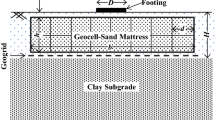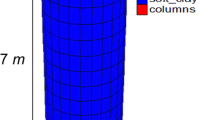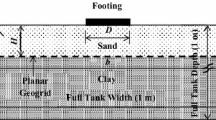Abstract
Over-excavation and replacement are the most commonly used ground modification techniques for shallow foundations. In soft soils, however, the extent of replacement by relatively larger (up to 19 mm) granular material was unknown. A total of 97 tests, consisting of 10 small and 87 numerical model tests, were carried out on two types of foundations, namely strip, and square. The width W and the depth of the replaced zone H were varied in each test and the ultimate bearing capacity qu was calculated. The experimental and numerical analyses were compared by computing qu from two methods (tangent intersection method (TIM) and 0.1B method). The improvement in qu was plotted as the dimensionless factor bearing capacity ratio (BCR) vs. depth ratio H/B for each foundation. A significant increase in BCR was observed from H/B of 1.5 to 4 for strip foundation and 2.5 to 3 for a square foundation. There was an insignificant increase in BCR after H/B of 4 and 3 for strip and square foundations, respectively. The width of the replacement was recommended as 2B for square foundations, while no value was suggested for strip foundation owing to a steady increase in the BCR. In addition, it has been observed that the depth of replacement is a major component in improving the bearing capacity compared to the width of replacement.




















Similar content being viewed by others
Data Availability
All data, models, and code generated or used during the study appear in the submitted article.
References
Lawton EC (2001) Section 6A “Soil Improvement and Stabilization”, Practical Foundation Engineering Handbook. McGraw-Hill, New York
Han J (2015) Principles and practice of ground improvement. Wiley, New York
Madhav MR, Vitkar PP (1978) Strip footing on weak clay stabilized with a granular trench or pile. Can Geotech J 15:600–605. https://doi.org/10.1139/t78-066
Abhishek SV, Rajyalakshmi K, Madhav MR (2014) Bearing capacity of strip footing on reinforced foundation bed over soft ground with granular trench. Indian Geotech J 45:304–317. https://doi.org/10.1007/s40098-014-0138-y
Michalowski RL, Shi L (1995) Bearing capacity of footings over two-layer foundation soils. J Geotech Eng 121:421–428. https://doi.org/10.1061/(ASCE)0733-9410(1995)121:5(421)
Bai X-H, Huang X-Z, Zhang W (2013) Bearing capacity of square footing supported by a geobelt-reinforced crushed stone cushion on soft soil. Geotext Geomembr 38:37–42. https://doi.org/10.1016/j.geotexmem.2013.04.004
Hemalatha A, Mahendran N, Ganesh Prabhu G (2014) Prediction of effects of geogrid reinforced granular fill on the behaviour of static liquefaction. Adv Mater Sci Eng 2014:1–11. https://doi.org/10.1155/2014/210843
Ornek M, Laman M, Demir A, Yildiz A (2012) Prediction of bearing capacity of circular footings on soft clay stabilized with granular soil. Soils Found 52:69–80. https://doi.org/10.1016/j.sandf.2012.01.002
Zhang W, Du D, Bai X (2018) In situ testing of square footing resting on geobelt-reinforced gravel thin cushion on soft silt. Adv Mater Sci Eng 2018:1–12. https://doi.org/10.1155/2018/3563914
Hamed H (1986) Bearing capacity of strip foundation on a granular trench in soft clay, University of Texas. El Paso. https://doi.org/10.4203/ccp.9.18.5
Khing KH, Das BM, Puri VK, Yen SC, Cook EE (1993) Foundation on strong sand underlain by weak clay with geogrid at the interface. Geotext Geomembr 13:199–206. https://doi.org/10.1016/0148-9062(95)90238-4
Lee KM, Manjunath VR, Dewaiker DM (1999) Numerical and model studies of strip footing supported by a reinforced granular fill–soft soil system. Can Geotech J 36:793–806. https://doi.org/10.5860/choice.41-2927.14
Rethaliya RP, Verma AK (2009) Strip footing on sand overlying soft clay with geotextile interface. Indian Geotech J 39:271–287
Kolay PK, Kumar S, Tiwari D (2013) Improvement of bearing capacity of shallow foundation on geogrid reinforced silty clay and sand. J Constr Eng 2013:1–10. https://doi.org/10.1155/2013/293809
Fattah MY, Al-Waily MJM (2015) Bearing capacity of foundations resting on a trench of local reclaimed asphalt pavement material. Glob J Eng Sci Res Manag 2:90–105
Dalaly NK, Al-Soud MS, Abdul Jabar SS (2015) A new technique of strengthening soft soil under a strip footing by a granular trench reinforced with geogrid micro mesh. Aust J Civ Eng 13:11–21. https://doi.org/10.1080/14488353.2015.1092633
Fattah MY, Al-Neami MA, Al-Suhaily AS (2015) Improvement of bearing capacity of footings on soft clay by partial soil replacement technique. 2nd International conference on building, construction, environmental engineering
Likitlersuang S, Surarak C, Wanatowski D, Oh E, Suwansawat S, Balasubramaniam A (2014) Simplified finite-element modelling for tunnelling-induced settlements. Geotech Res 1:133–152. https://doi.org/10.1680/gr.14.00016
Likitlersuang S, Surarak C, Wanatowski D, Oh E, Balasubramaniam A (2013) Finite element analysis of a deep excavation: a case study from the Bangkok MRT. Soils Found 53:756–773. https://doi.org/10.1016/j.sandf.2013.08.013
Likitlersuang S, Chheng C, Surarak C, Balasubramaniam A (2018) Strength and stiffness parameters of Bangkok clays for finite element analysis. Author Downloaded from Griffith Research Online Strength and Stiffness Parameters of Bangkok Clays for Finite Element Analysis. https://doi.org/10.1016/j.sandf.2012.07.009
Unnikrishnan N, Johnson AS, Rajan S (2010) Response of strip footings supported on granular trench. In: Indian geotechnical conference, pp 525–528
Unnikrishnan N, Rajan S, Johnson AS (2011) Bearing capacity of strip footings on encapsulated granular trenches. In: Indian geotechnical conference
Kumar J, Chakraborty M (2015) Bearing capacity of a circular foundation on layered sand-clay media. Soils Found 55:1058–1068. https://doi.org/10.1016/j.sandf.2015.09.008
Gupta R, Trivedi A (2009) Bearing capacity and settlement of footing resting on confined loose silty sands. Electron J Geotech Eng 14A:1–17
Aparna SR, Unnikrishnan N (2016) Behaviour of strip footing supported on stressed encapsulated granular trenches. Int J Innov Res Sci Eng Technol 5:292–302
Hasanzadeh A, Choobbasti AJ (2016) Estimation of bearing capacity of circular footings on clay stabilized with granular soil: case study. Int J Civ Eng Geo-Environ 6:47–54
Fattah MY, Al-Baghdadi W, Omar M, Shanableh A (2010) Analysis of strip footings resting on reinforced granular trench by the finite element method. Int J Geotech Eng 4:471–482. https://doi.org/10.3328/ijge.2010.04.04.471-482
Bouassida M, Jellali B, Lyamin A (2014) Ultimate bearing capacity of a strip footing on ground reinforced by a trench. Int J Geomech 15:1–8. https://doi.org/10.1061/(ASCE)GM.1943-5622.0000418
Ranjbar A, Golshani AA (2018) The effect of granular trench’s depth on bearing capacity of shallow foundations on the soft ground. J New Approach Civ Eng 2:39–48. https://doi.org/10.30469/JNACE.2018.69393
Bhattacharya P, Kumar J (2017) Bearing capacity of foundations on soft clays with granular column and trench. Soils Found 57:488–495. https://doi.org/10.1016/j.sandf.2017.05.013
ASTM D 698 (2009) Standard test methods for laboratory compaction characteristics of soil using standard effort (12400 ft-lbf/ft3 (600 kN-m/m3)), 1–13. https://doi.org/10.1520/D0698-12R21
ASTM D 2216 (2000) Standard test method for unconfined compressive strength of cohesive soil, 1–6. https://doi.org/10.1520/D2166-00
Wroth CP, Wood DM (1978) The correlation of index properties with some basic engineering properties of soils. Can Geotech J 15:137–145
Terzaghi K, Peck RB, Mesri G (1996) Soil mechanics in engineering practice, 3rd edn. Wiley, New York
Cerato AB, Lutenegger AJ (2005) Bearing capacity of square and circular footings on a finite layer of granular soil underlain by a rigid base. J Geotech Geoenviron Eng 132:1496–1501. https://doi.org/10.1061/(ASCE)1090-0241(2006)132:11(1496)
ASTM D 2850 (2003) Standard test method for unconsolidated-undrained triaxial compression test on cohesive soils, 1–6. https://doi.org/10.1520/D2850-15
ASTM D 5084 (2010) Standard test methods for measurement of hydraulic conductivity of saturated porous materials using a flexible wall permeameter, 1–24. https://doi.org/10.1520/D5084-10
ASTM D 6913 (2004) Standard test methods for particle-size distribution (gradation) of soils using sieve, 1–34. https://doi.org/10.1520/D6913-04R09E01.2
ASTM C 127 (2007) Standard test method for density, relative density (specific gravity), and absorption of coarse aggregate, 1–7. https://doi.org/10.1520/C0127-15
ASTM D 854 (2002) Standard test methods for specific gravity of soil solids by water pycnometer, 1–7. https://doi.org/10.1520/D0854-14
ASTM D 4318 (2000) Standard test methods for liquid limit, plastic limit, and plasticity index of soils, 1–14. https://doi.org/10.1520/D4318-17E01
ASTM D 2487 (2000) Standard practice for classification of soils for engineering purposes (unified soil classification system), 04:1–12. https://doi.org/10.1520/D2487-17E01
ASTM D 4718 (1987) Standard practice for correction of unit weight and water content for soils containing oversize particles, 1–3. https://doi.org/10.1520/D4718-87R07.2
ASTM D 3080 (2011) Standard test method for direct shear test of soils under consolidated drained, 1–9. https://doi.org/10.1520/D3080
Alias R, Kasa A, Taha MR (2014) Particle size effect on shear strength of granular materials in direct shear test. Int J Civ Archit Struct Constr Eng 8:1084–1087. https://doi.org/10.5281/zenodo.1096805
Nakao T, Fityus S (2008) Direct shear testing of a marginal material using a large shear box. Geotech Test J 31:10. https://doi.org/10.1520/GTJ101237
NAVFAC (1986) Soil Mechanics Design Manual 7.01, 7.1-139
Habib PA (1974) Scale effect for shallow footings on dense sand. J Geotech Geoenviron Eng 100:95–99
Brinkgreve RBJ, Broere W, Waterman D (2004) Plaxis finite element code for soil and rock analysis, 2D—Version 8
Cicek E, Guler E (2015) Bearing capacity of strip footing on reinforced layered granular soils. J Civ Eng Manag 21:605–614. https://doi.org/10.3846/13923730.2014.890651
Ornek M, Demir A, Laman M, Yildiz A (2012) Numerical analysis of circular footings on natural clay stabilized with a granular fill. ACTA Geotech Slov 1:61–75
Obrzud RIF, Truty A (2018) The hardening soil model—a practical guidebook Z soil, 71
AASHTO (2012) AASHTO LRFD Bridge Design Specifications, American Association of State Highway and Transportation Officials, Washington, DC
Bolton MD (1986) The strength and dilatancy of sands. Geotechnique 36:65–78. https://doi.org/10.1680/geot.1986.36.1.65
Potyondy JG (1961) Skin friction between various soils and construction materials. Géotechnique 11:339–353. https://doi.org/10.1680/geot.1961.11.4.339
Chen S-L, Li S-F, Fang S-F (1994) Elastoplastic large deflection analysis of cold-formed members using spline finite strip method. In: Twelfth international special conference on cold-formed steel structures, St. Louis, pp 251–263
Vesic AS (1973) Analysis of ultimate loads of shallow foundations. J Soil Mech Found Div 99:45–73
Binquet J, Lee KL (1975) Bearing capacity tests on reinforced earth slabs. J Geotech Eng Div 101:1241–1255
Al-Shenawy AO, Al-karni A (2005) Derivation of bearing capacity equation for a two layered system of weak clay layer overlaid by dense sand layer. Pertanika J Sci Technol 13:213–235
Ismail Ibrahim KMH (2014) Bearing capacity of circular footing resting on granular soil overlying soft clay. Hous Build Natl Res Cent J 12:71–77. https://doi.org/10.1016/j.hbrcj.2014.07.004
Kumar A, Ohri ML, Bansal RK (2006) Bearing capacity tests of strip footings on reinforced layered soil. Geotech Geol Eng 25:139–150. https://doi.org/10.1007/s10706-006-0011-6
Funding
This research received no external funding.
Author information
Authors and Affiliations
Contributions
The main idea was conceptualized by ZBM and SMJ, while the methodology was defined by ZBM and BA. The material was collected by ZBM. The experimental part was implemented by ZBM with the help of DU under the supervision of BA. The original draft was prepared by ZBM with help of DU. The review of the manuscript was done by BA. The overall work was carried out under the supervision of BA and SMJ.
Corresponding author
Ethics declarations
Conflict of interest
The authors declare that there is no conflict of interest regarding the publication of this article.
Originality statement
The manuscript of this paper, even with a minor overlap with text, research objectives, presentation of research data, figures/photographs, tables, research findings, conclusions, etc., has not been submitted to any other journal for simultaneous consideration. Also, no part of this paper manuscript has been published earlier by me/us and others at any publication platform (technical journal, conference proceedings, magazine, newspaper, etc.). The details as reported in this paper are truly my/our unpublished original research work in all aspects.
Additional information
Publisher's Note
Springer Nature remains neutral with regard to jurisdictional claims in published maps and institutional affiliations.
Rights and permissions
About this article
Cite this article
Malik, Z.B., Alshameri, B., Jamil, S.M. et al. Experimental and Numerical Modeling of Bearing Capacity of Foundations on Soft Clay Stabilized with Granular Material. Int. J. of Geosynth. and Ground Eng. 7, 91 (2021). https://doi.org/10.1007/s40891-021-00334-2
Received:
Accepted:
Published:
DOI: https://doi.org/10.1007/s40891-021-00334-2




